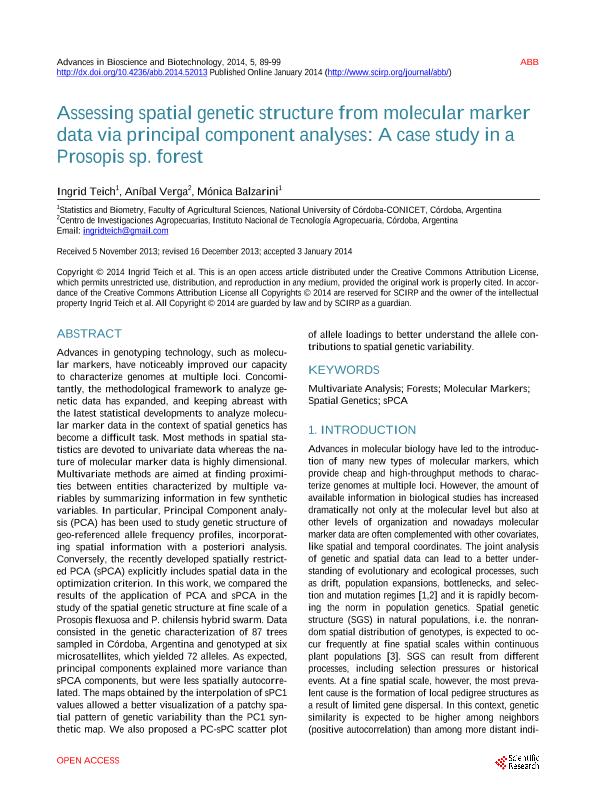Mostrar el registro sencillo del ítem
dc.contributor.author
Teich, Ingrid

dc.contributor.author
Verga, Aníbal Ramón

dc.contributor.author
Balzarini, Monica Graciela

dc.date.available
2018-01-18T14:34:11Z
dc.date.issued
2014-01
dc.identifier.citation
Teich, Ingrid; Verga, Aníbal Ramón; Balzarini, Monica Graciela; Assessing spatial genetic structure from molecular marker data via principal component analyses: A case study in a Prosopis sp. forest; Scientific Research Publishing; Advances in Bioscience and Biotechnology; 5; 2; 1-2014; 89-99
dc.identifier.issn
2156-8456
dc.identifier.uri
http://hdl.handle.net/11336/33768
dc.description.abstract
Advances in genotyping technology, such as molecular markers, have noticeably improved our capacity to characterize genomes at multiple loci. Concomitantly, the methodological framework to analyze genetic data has expanded, and keeping abreast with the latest statistical developments to analyze molecular marker data in the context of spatial genetics has become a difficult task. Most methods in spatial statistics are devoted to univariate data whereas the nature of molecular marker data is highly dimensional. Multivariate methods are aimed at finding proximities between entities characterized by multiple variables by summarizing information in few synthetic variables. In particular, Principal Component analysis (PCA) has been used to study genetic structure of geo-referenced allele frequency profiles, incorporating spatial information with a posteriori analysis. Conversely, the recently developed spatially restricted PCA (sPCA) explicitly includes spatial data in the optimization criterion. In this work, we compared the results of the application of PCA and sPCA in the study of the spatial genetic structure at fine scale of a Prosopis flexuosa and P. chilensis hybrid swarm. Data consisted in the genetic characterization of 87 trees sampled in Córdoba, Argentina and genotyped at six microsatellites, which yielded 72 alleles. As expected, principal components explained more variance than sPCA components, but were less spatially autocorrelated. The maps obtained by the interpolation of sPC1 values allowed a better visualization of a patchy spatial pattern of genetic variability than the PC1 synthetic map. We also proposed a PC-sPC scatter plot of allele loadings to better understand the allele contributions to spatial genetic variability.
dc.format
application/pdf
dc.language.iso
eng
dc.publisher
Scientific Research Publishing
dc.rights
info:eu-repo/semantics/openAccess
dc.rights.uri
https://creativecommons.org/licenses/by-nc-sa/2.5/ar/
dc.subject
Multivariate Analysis
dc.subject
Forests
dc.subject
Molecular Markers
dc.subject
Spatial Genetics
dc.subject
Spca
dc.subject.classification
Otras Ciencias Biológicas

dc.subject.classification
Ciencias Biológicas

dc.subject.classification
CIENCIAS NATURALES Y EXACTAS

dc.subject.classification
Otras Biotecnología Agropecuaria

dc.subject.classification
Biotecnología Agropecuaria

dc.subject.classification
CIENCIAS AGRÍCOLAS

dc.title
Assessing spatial genetic structure from molecular marker data via principal component analyses: A case study in a Prosopis sp. forest
dc.type
info:eu-repo/semantics/article
dc.type
info:ar-repo/semantics/artículo
dc.type
info:eu-repo/semantics/publishedVersion
dc.date.updated
2018-01-17T15:02:22Z
dc.journal.volume
5
dc.journal.number
2
dc.journal.pagination
89-99
dc.journal.pais
Estados Unidos

dc.description.fil
Fil: Teich, Ingrid. Consejo Nacional de Investigaciones Científicas y Técnicas; Argentina. Universidad Nacional de Córdoba. Facultad de Ciencias Agropecuarias. Departamento de Desarrollo Rural. Area de Estadística y Biometría; Argentina
dc.description.fil
Fil: Verga, Aníbal Ramón. Instituto Nacional de Tecnología Agropecuaria. Centro de Investigaciones Agropecuarias; Argentina
dc.description.fil
Fil: Balzarini, Monica Graciela. Consejo Nacional de Investigaciones Científicas y Técnicas; Argentina. Universidad Nacional de Córdoba. Facultad de Ciencias Agropecuarias. Departamento de Desarrollo Rural. Area de Estadística y Biometría; Argentina
dc.journal.title
Advances in Bioscience and Biotechnology
dc.relation.alternativeid
info:eu-repo/semantics/altIdentifier/doi/http://dx.doi.org/10.4236/abb.2014.52013
dc.relation.alternativeid
info:eu-repo/semantics/altIdentifier/url/http://file.scirp.org/Html/2-7300780_42409.htm
Archivos asociados
